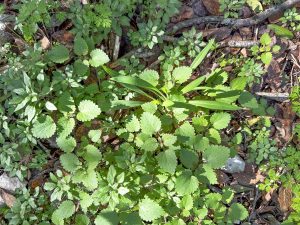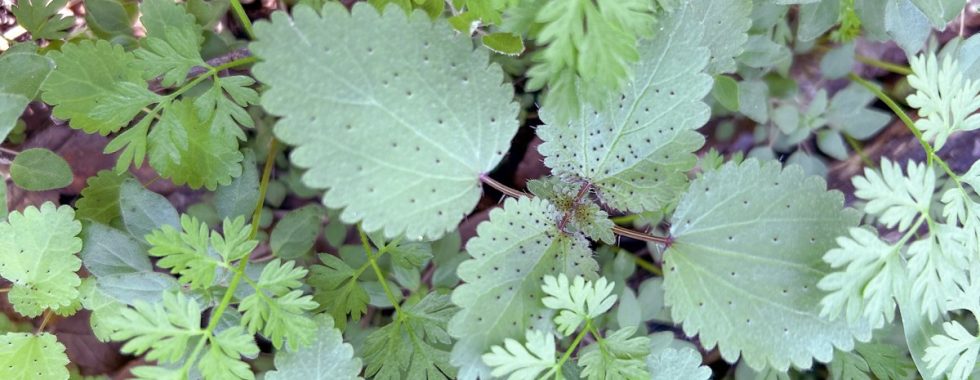Trail Notes: “The Sting That Heals”
“Hot dog!” I thought the first time I came across this plant growing in our woods. “Is this mint? Some kind of salvia? Why, it even looks a lot like lemon balm.” I was wrong on every count. This was Urtica dioica, better known as stinging nettle.
 What told me I wasn’t dealing with something as innocuous as mint was the incredible burning sensation I felt when I pulled off a leaf to get a better look. Duh. Note to self: Put this plant in the category of Touch Me Nots.
What told me I wasn’t dealing with something as innocuous as mint was the incredible burning sensation I felt when I pulled off a leaf to get a better look. Duh. Note to self: Put this plant in the category of Touch Me Nots.
Growing up on the Texas coast, I had encountered bull nettle (Cnidoscolus texanus) many times, usually while traipsing through a field with my dog. Stinging nettle, on the other hand, was new to me. Unlike bull nettle, to which it is unrelated, stinging nettle doesn’t have the good grace to at least look scary. No, it just sits there all pretty and little and green, waiting for someone to dare to yank it out. This time of year, especially, the plant is still small, belying the fact that come summer, it will reach a height anywhere between 3 and 10 feet, depending on water and soil.
So what makes this plant so fearsome? According to The Ohio University’s “Perennial and Biennial Weed Guide,” “Stinging hairs on the stem and leaves of stinging nettle cause irritation upon contact with skin. The toxins are located at the base of each stinging hair. When skin brushes against the stinging hairs, the bulbous tip of each hair readily breaks off, forming a sharp shaft that acts like a hypodermic needle to inject the toxins into the skin, causing localized pain, reddish swelling, itching and numbness.” Plants with hypodermics—sounds like the stuff of horror films.
While some lucky people have very mild reactions to these toxins, others develop a rash, similar to that caused by poison ivy, or even oozing blisters. Writing in the Jan. 1, 2019, issue of The Herbalist, Carol Ann Harlos notes, “The ’hairs,’ called triochomes, inject a victim with a cocktail of compounds including: the neurotransmitters acetylocholine, histamine, and serotonin; moroiodin, a small peptide that is responsible for the pain response; leukotrienes, which are products of the white blood cells that induce inflammation; and formic acid, which is a compound of ant venom. . . . The combination of these chemicals causes paresthesia commonly described as a tingling or prickling feeling.”
That “paresthesia” is precisely the reaction I have to stinging nettle. The burning sensation subsides quickly, but eerie numbness in my fingers can last for days.
Given how formidable stinging nettle can be, you might imagine my surprise on learning what a pharmaceutical and nutritional cornucopia it is. You name it, and stinging nettle has probably been used to treat it.
Mount Sinai Hospital’s Health Library describes some of its applications: “Stinging nettle has been used for hundreds of years to treat painful muscles and joints, eczema, arthritis, gout, and anemia. Today, many people use it to treat urinary problems during the early stages of an enlarged prostate (called benign prostatic hyperplasia or BPH).” Hayfever, flu, labor pains—stinging nettle supposedly addresses them all. On a deep dive into a scientific database, I found that studies abound on the medical benefits of this plant, including its possible use in treating diabetes and high blood pressure.
Most treatments with stinging nettle involve drinking a tea or taking the plant in capsule form, but according to Mt. Sinai Hospital, the leaves themselves can be applied directly to an achy joint. Why doesn’t this hurt? The site explains, “When [the leaves] come into contact with a painful area of the body, . . . they can actually decrease the original pain. Scientists think nettle does this by reducing levels of inflammatory chemicals in the body, and by interfering with the way the body transmits pain signals.”
But there’s more.
If you aren’t interested in drinking stinging nettle tea for your gout or rubbing it on your achy knees, you might try it for its nutritional benefits and flavor. “Nettles cooked into a soup or chopped finely and served as a potherb are excellent dishes and are both starting to show up in major restaurants like Chez Panisse in Berkeley, California,” Nat Bletter of Brooklyn Botanic Garden wrote in 2008. “The leaves are very high in vitamin C, calcium, and iron (up to six times more than in spinach) and have a lovely, delicate taste when lightly blanched. It is best to use only the leaves for cooking, since the stems contain a lot of silica.”
Not every culinary setting features that “delicate taste,” however. Begun in the British village of Marshwood in 1997, the World Nettle Eating Championship is all about quantity, not quality. The travel website Matador Network describes the event in this way: “The setup is similar to any other eating competition; challengers sit at a table and hordes of spectators cheer them on. Only, instead of piles of food, there are piles of stinging nettles. The nettles are cut down to 2-feet-long stalks, and each competitor has an hour to pluck and eat as many stinging nettle leaves as possible. This includes anything else that might be on those nettles too — including the occasional bug or two. At the end, the bare stalks are counted and measured, and the winner is the person who ate the longest length.” The record was set in 2018 when a contestant succeeded in eating 104 feet. Enough said about that.
 Moving now from the ridiculous to the practical, stinging nettle has had any number of everyday uses throughout history—as a rinse to promote hair growth, as nutritious hay for cattle forage, as fiber for yarn, ropes, paper, and textiles, and much more.
Moving now from the ridiculous to the practical, stinging nettle has had any number of everyday uses throughout history—as a rinse to promote hair growth, as nutritious hay for cattle forage, as fiber for yarn, ropes, paper, and textiles, and much more.
None of these uses are what I think about, though, as I move through our woods these days. Granted, I do pull the stinging nettle from areas in the yard where I work—using gloves, of course—but I resist the temptation to do so in the area I leave more or less wild. Here I’ll let the colonies of stinging nettle grow, spreading as they do by seeds and rhizomes. These are the plants that will nourish bees when they bloom come summer and birds when the seeds appear in fall. They’ll play host to the ladybugs that feed on the aphids sheltering in the leaves. And most notably, they’ll provide a place for a variety of butterfly species—painted ladies, question marks, tortoiseshells and peacocks, and especially the red admiral, whose larvae feed only on stinging nettle.
In short, stinging nettle is one of those complicated plants that we both love and hate. Writing in Oregon WildBlog, Chandra LeGue recalls being warned about stinging nettle by her camp counselors in the woods of Virginia. She explains, “If the leaves grazed your skin you would feel a burning and stinging sensation a few minutes later. This always stuck with me as a kid and I tried to stay as far away from these prickly plants as possible. Since then I have come to appreciate the stinging nettle, both for how the sting operates as well as the myriad human uses for the plant.” I think I have, too.
Written by Susan Hanson, editor, The Loop.


